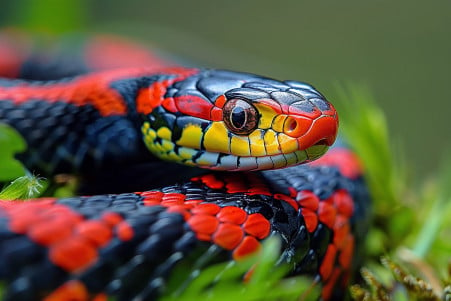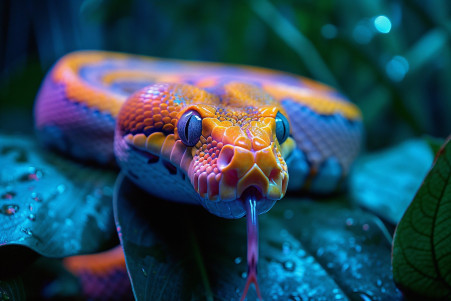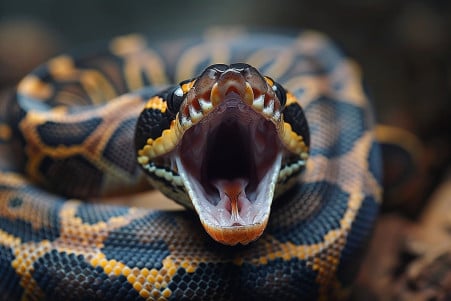Do Snakes Sleep? Exploring Their Resting Behaviors
6 May 2024 • Updated 6 May 2024

While everyone is familiar with the way snakes move and the sounds they make, you may not be as familiar with their sleep patterns. That's because snakes don't sleep in the way that humans do. Instead, they have rest periods that are similar to sleep, but they keep their eyes open and are able to respond to threats. Snakes also don't have sleep stages or REM sleep like humans.
In this article, we'll look at research on snake behavior and physiology to learn more about their rest, basking, and energy conservation patterns. In doing so, we'll explore these ectothermic reptiles and gain a better understanding of how sleep is defined in the animal kingdom. This research area is interesting because it shows the diversity of life and the evolutionary pros and cons that snakes have to deal with when it comes to their sleep-like states.
Do Snakes Sleep?
How Snakes Physiologically Sleep With Their Eyes Open
Snakes don’t have eyelids, but they do have a clear, protective scale called a spectacle or brille that covers their eyes. This scale is a modified nictitating membrane, which, according to Wikipedia, is a translucent third eyelid that can be drawn across the eye for protection while still allowing the animal to see.
The spectacle is a nictitating membrane that covers the eye, but it doesn’t cover it completely. Instead, it leaves a small gap that allows the snake to see while protecting the eye from debris. Snakes also have a lacrimal system and tear glands that help keep the eye moist while the snake sleeps. As OddlyCutePets.com explains, the spectacle allows the eye to be covered while still allowing fluid from the tear glands to keep the eye moist.
One study published in PMC explains that in snakes, the serous Harderian gland is responsible for producing the tear film that fills the space between the spectacle and the eye. The spectacle is replaced during each shedding cycle, which helps ensure that the snake’s vision isn’t compromised. As ScienceNews reports, the spectacle becomes opaque as new layers form on top of the old ones before the snake sheds, but after the snake sheds, the spectacle becomes clear again.
This adaptation allows snakes to sleep with their eyes open while still being able to see and respond to threats in their environment.
Sleep Cycles and How They're Influenced
Snakes are known to sleep for a large portion of the day, with the average being around 16 hours a day and some species sleeping as much as 22 hours a day, according to Mattress Clarity. A snake's sleep cycles and the length of time they sleep are influenced by a number of factors, including temperature, light, and seasonal changes.
Snakes can be nocturnal, diurnal, or crepuscular (active at dawn and dusk) depending on their species and hunting behavior. The blog post "Life is short, but snakes are long: Do snakes sleep?" explains that racers, hog-nosed snakes, and sipos are diurnal, while nightsnakes, broad-headed snakes, and kraits are nocturnal. However, there are many exceptions to these rules.
Smaller and younger snakes tend to sleep more than older, larger snakes, according to the PDF on the Ecology of Sleep in Reptiles. In addition, environmental factors, including temperature and the length of the day, are important in determining the length of a snake's sleep cycle. Snakes sleep more when it's cooler and the days are shorter.
Sleeping Behaviors and Predation Strategies
Sleep is important for snakes in terms of energy restoration, hormone regulation, and energy conservation during periods of fasting, according to Snakes Sleeping. Snakes seek out safe, hidden places to sleep, like burrows or tree cavities, to avoid predators. As the blog post on snake predation strategies explains, some snakes have even evolved special features like heat-sensing pits and forked tongues that help them with hunting and finding safe places to sleep.
Nocturnal snakes are active at night and sleep during the day, while diurnal snakes are active during the day and sleep at night, according to What Time Of Night Are Snakes Most Active?. However, even when they are sleeping, snakes are always aware of their surroundings and are constantly using their senses to monitor their environment, which allows them to react quickly if necessary. This ability to stay alert is an important adaptation that allows snakes to conserve energy while still protecting themselves from potential threats.
Variation in Snake Sleep Among Different Species
Given the incredible diversity of snakes, it's not surprising that there is a wide range of sleeping patterns and behaviors among different species. As the blog post "Life is short, but snakes are long: Do snakes sleep?" explains, arboreal snakes like tree snakes and ball pythons are known to sleep draped or coiled over tree limbs and branches, while ground-dwelling species such as sand boas and garter snakes are more likely to sleep in piles of debris or under the substrate.
Meanwhile, some snakes, like the bushmasters (Lachesis muta), may use a sleeping strategy in which they "sleep one hemisphere of their brain at a time, similar to some marine mammals and migratory birds," the blog post explains. This allows them to be partially awake while still saving energy as sit-and-wait foragers.
The PDF on the Ecology of Sleep in Reptiles explains that a snake's specific sleeping behavior is likely to be influenced by a number of factors, including its habitat, the availability of prey, and the presence of predators. More research is needed to fully understand the many ways that snakes have adapted to sleep.
Conclusion: The Unique World of Snake Sleep
More recent studies have shown that reptiles, including snakes, go through sleep cycles similar to those of humans and other mammals. Not only have snakes been shown to experience slow-wave sleep, but they have also been shown to experience rapid eye movement (REM) sleep, which is typically associated with dreaming. This suggests that snakes have a more complex sleep system than was previously understood.
As a Scientific American article explains, reptiles have been observed to go through the same sleep cycles as mammals, which means that snakes go through the same sleep cycles as other animals, even if they do so in a way that's very different from humans. Slow-wave sleep is a stage of deep sleep that is important for memory consolidation and restorative processes.
Snakes sleep with their eyes open because they lack eyelids. Instead, they have a transparent scale called a "brille" that covers and protects their eyes. As described on Discover Creatures, the brille allows snakes to see while keeping their eyes safe from debris and irritants. Snakes may also use other behaviors like lowering their head to the ground to help keep their eyes clean while sleeping.
Although the way snakes sleep may seem alien to humans, they still need to rest and recover from the energy they expend while hunting and digesting their food. This means that even though snakes may not sleep in a way that's familiar to us, they still need to rest and recover. This is especially important for snakes that are kept in captivity, as they need to be able to rest and recover in order to stay healthy.


